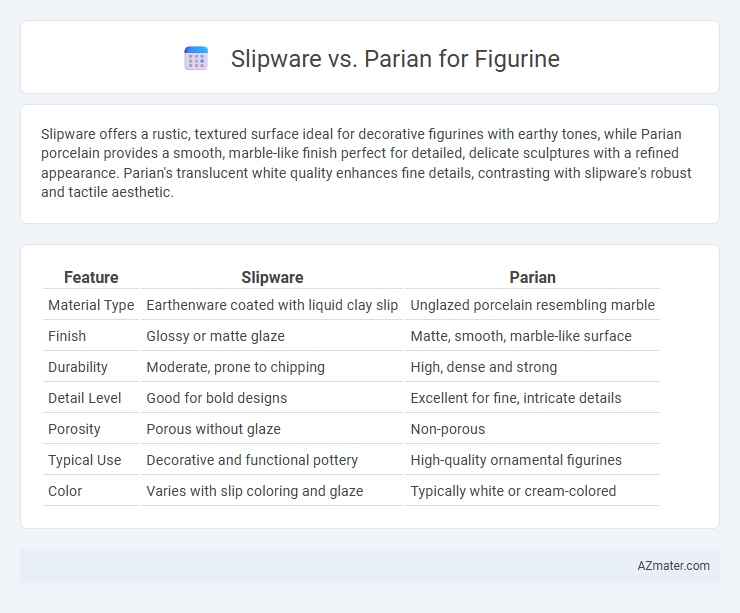Slipware offers a rustic, textured surface ideal for decorative figurines with earthy tones, while Parian porcelain provides a smooth, marble-like finish perfect for detailed, delicate sculptures with a refined appearance. Parian's translucent white quality enhances fine details, contrasting with slipware's robust and tactile aesthetic.
Table of Comparison
| Feature | Slipware | Parian |
|---|---|---|
| Material Type | Earthenware coated with liquid clay slip | Unglazed porcelain resembling marble |
| Finish | Glossy or matte glaze | Matte, smooth, marble-like surface |
| Durability | Moderate, prone to chipping | High, dense and strong |
| Detail Level | Good for bold designs | Excellent for fine, intricate details |
| Porosity | Porous without glaze | Non-porous |
| Typical Use | Decorative and functional pottery | High-quality ornamental figurines |
| Color | Varies with slip coloring and glaze | Typically white or cream-colored |
Introduction to Slipware and Parian Figurines
Slipware figurines are crafted using clay coated with a liquid clay slip, allowing for intricate surface decoration and vibrant glaze effects that highlight detailed textures. Parian figurines, made from a refined, unglazed porcelain resembling marble, offer a smooth, matte finish ideal for classical and realistic sculptures with fine facial features. Both techniques showcase unique artistic qualities, with slipware emphasizing decorative color and texture, while Parian excels in elegant, lifelike purity.
Historical Background of Slipware
Slipware, a ceramic technique dating back to ancient times, involves coating pottery with liquid clay slip to create decorative surfaces, widely popular in medieval Europe and East Asia. This method gained prominence in the 17th and 18th centuries for figurines due to its versatility in producing vibrant, textured designs compared to the porcelain-like Parian, developed in the 19th century as a refined, unglazed white ware mimicking marble. Slipware's historical significance lies in its artisanal craftsmanship and regional variations, often reflecting cultural aesthetics and technological advancements preceding the industrial age of Parian figurines.
Origins and Development of Parian Ware
Parian ware, developed in the early 19th century in England, is a type of unglazed porcelain resembling marble, prized for its fine detail and smooth finish in figurines. Unlike slipware, which involves coating pottery with a liquid clay slip for decoration or protection, Parian ware uses a refined white clay mixture fired at high temperatures to achieve its characteristic translucency and durability. The development of Parian ware marked a significant advancement in ceramic art, allowing mass production of affordable yet elegant sculptures inspired by classical marble statuary.
Material Composition: Slipware vs Parian
Slipware figurines are crafted using a clay body coated with liquid clay slip, which provides a textured surface that can be glazed in various colors, enhancing durability and visual appeal. Parian figurines are made from a fine, white, unglazed porcelain resembling marble, composed of kaolin and feldspar, prized for its smooth, translucent finish and delicate detail. The material composition of slipware results in more rustic, earthy tones, while Parian's composition allows for refined, lifelike sculptures with a polished, marble-like appearance.
Artistic Techniques and Craftsmanship
Slipware figurines showcase intricate surface decoration achieved by applying liquid clay slip, allowing for detailed patterns and textured finishes that highlight the artisan's precision. Parian figurines emulate the translucent quality of marble using fine, unglazed porcelain, emphasizing smooth surfaces and delicate sculptural details that reflect refined craftsmanship. Both techniques demand specialized skills, with slipware focusing on painted or carved embellishments, while Parian prioritizes subtle modeling and lifelike representations.
Aesthetic Qualities and Surface Finishes
Slipware figurines showcase a rustic, textured surface achieved by applying liquid clay slip, creating rich, varied tones and tactile patterns that highlight artisanal craftsmanship. Parian figurines feature an ultra-smooth, matte finish resembling fine porcelain, with a translucent quality that captures intricate details and delicate contours, enhancing their lifelike appearance. The contrast between slipware's earthy visual warmth and Parian's refined elegance makes each suited to different aesthetic preferences and display contexts.
Durability and Maintenance Considerations
Slipware figurines exhibit moderate durability due to their porous surface, requiring careful handling and sealed finishes to resist moisture and staining over time. Parian figurines, made from unglazed, fine-pored porcelain, offer superior durability with a dense, chip-resistant structure that simplifies maintenance by minimizing absorption and surface damage. Regular dusting and gentle cleaning with a soft cloth preserve both materials, though Parian's non-porous nature demands less frequent sealing compared to slipware.
Popular Uses in Figurine-Making
Slipware is popular for creating figurines with intricate surface textures and colorful, glossy finishes due to its ability to hold detailed slip decoration and vibrant glaze. Parian, known for its porcelain-like, matte finish and fine, smooth texture, is favored for producing highly detailed, lifelike figurines that resemble marble sculptures. Both materials are widely used in collectible figurines, with slipware excelling in decorative, rustic styles and Parian preferred for refined, classical sculptures.
Collectibility and Market Value
Slipware figurines, characterized by their distinctive glazed surfaces and intricate slip decoration, often appeal to collectors valuing traditional craftsmanship and unique artistic expression, which can drive niche market demand. Parian figurines, made from unglazed porcelain resembling marble, hold significant collectibility due to their fine detail and resemblance to classical sculptures, often commanding higher market values in the antique and art collectible sectors. The market value of Parian pieces generally surpasses that of Slipware, attributed to its rarity, material quality, and historical significance in Victorian-era production.
Choosing Between Slipware and Parian for Figurines
Choosing between slipware and Parian for figurines hinges on the desired finish and texture; slipware features a glossy, smooth surface achieved by applying liquid clay slip, making it ideal for vibrant, painted designs. Parian, a type of bisque porcelain, offers a matte, unglazed finish resembling marble, perfect for delicate, highly detailed figurines with a fine, sculptural quality. Consider slipware for colorful, durable pieces and Parian for elegant, refined collectibles with a soft, porcelain-like appearance.

Infographic: Slipware vs Parian for Figurine
 azmater.com
azmater.com